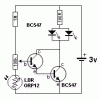Can anyone assist me with making a LDR switch? I specifically need a high efficiency and inexpensive setup since the intended circuit will run off of one 2032 battery. The switched circuit will consist of two small led's and a very low draw IC.
The switch as pictured below gets switched on when the LDR goes dark and off when there is sufficient ambient light. The 10k pot will allow for some adjustment to the light intensity cutoff, but may be omitted in future circuit if a specific value can be found by trial and error.
My existing setup shown below consumes 0.12mA while in standby - i.e. while its bright and the switched circuit is held in off state - about 78 days in standby until the battery is drained (assuming a 2032 has 225mAh).

The switch as pictured below gets switched on when the LDR goes dark and off when there is sufficient ambient light. The 10k pot will allow for some adjustment to the light intensity cutoff, but may be omitted in future circuit if a specific value can be found by trial and error.
My existing setup shown below consumes 0.12mA while in standby - i.e. while its bright and the switched circuit is held in off state - about 78 days in standby until the battery is drained (assuming a 2032 has 225mAh).

